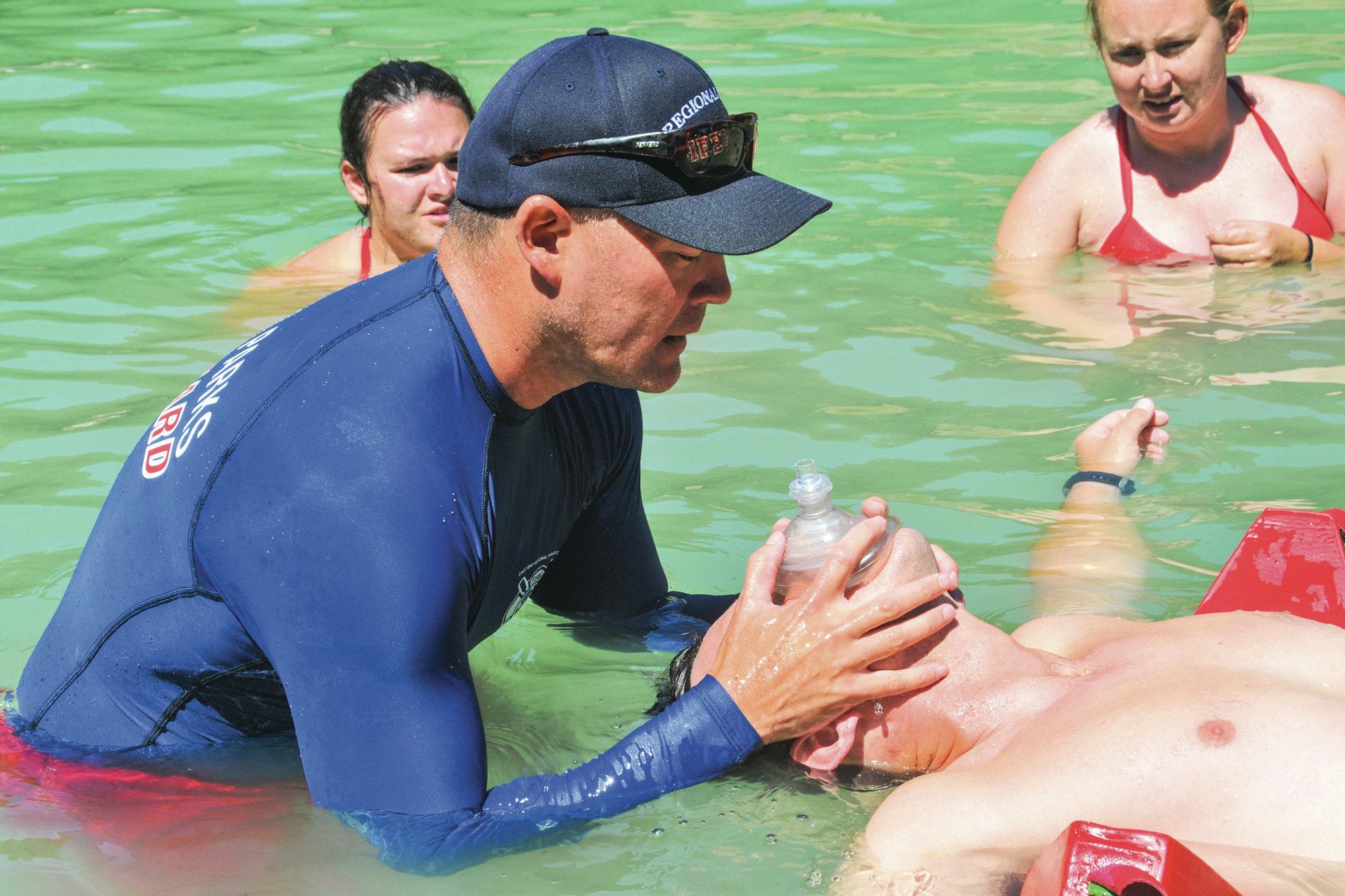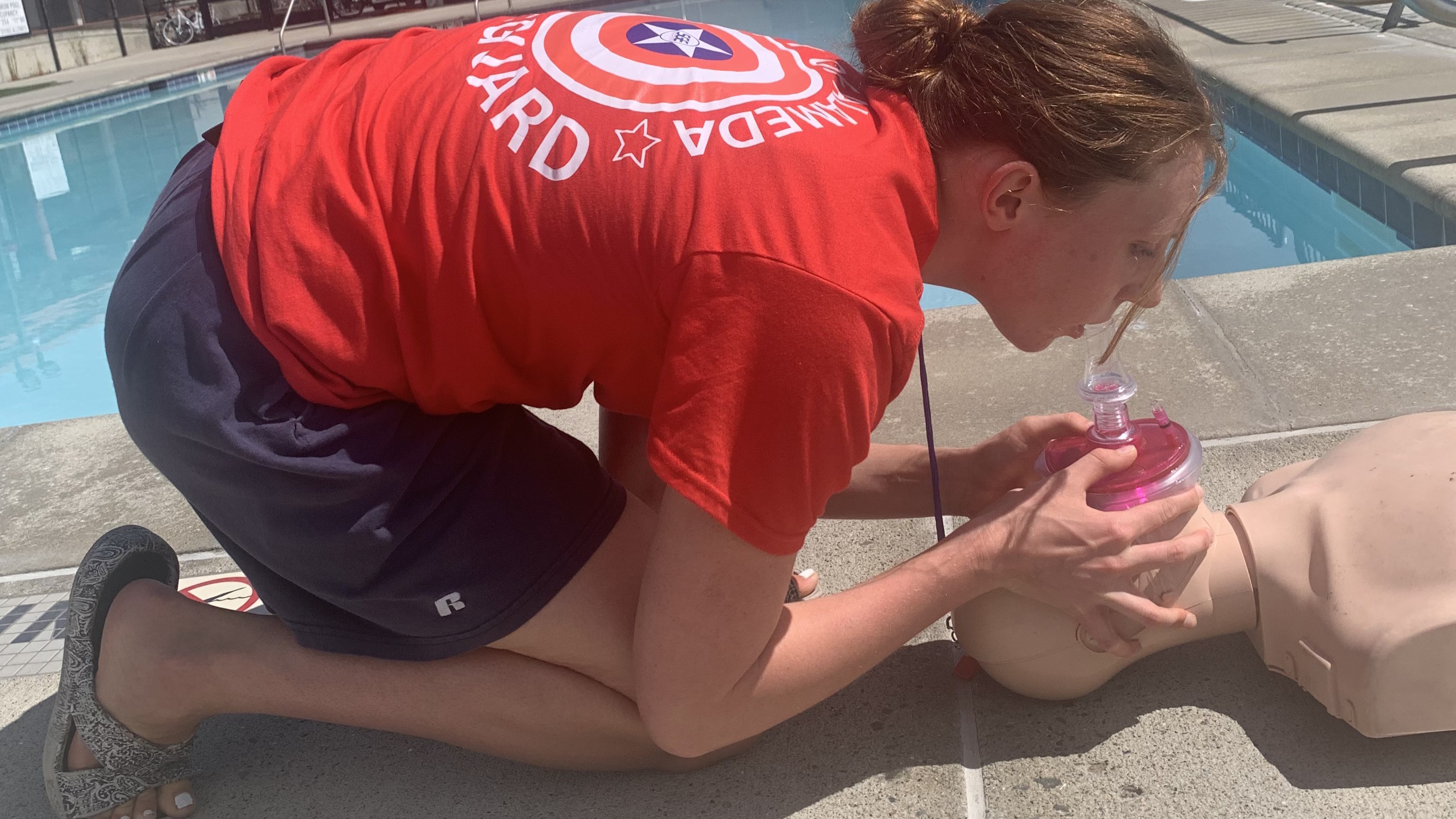Traditional lifeguard certification classes are held during Spring Break, meaning a new batch of lifeguards will soon be joining the ranks of aquatics agencies across the country. These new lifeguards will be enthusiastic, energized, and ready to be part of your drowning-prevention operation. However, they will be inexperienced and not have the proficiency to be rescue-ready. It might take several in-service trainings before your new lifeguards have the capacity to take initiative and play their part within a rescue response team.
To meet your goal of making your new lifeguards ready, you should share rescue data, train for speed in the water, train for multi-rescuer response to water rescues and assists, and develop proficiency in both giving ventilations and providing patient care as a rescue team.
Share your agency’s data of where all rescues and assists occurred. This should be represented on an aerial view of your facility that shows where rescues occur: red dots for rescues and assists, blue dots for medicals. Do a walkthrough so the new lifeguards can connect the rescue data to the most common rescue and medical locations.
Let’s review some drills which will assist in getting your new lifeguards ready for the summer.
SPEED RESCUE DRILL: Referring to the sample map, place a passive victim on the surface head-up (real person preferred) at Rescue Point 1, and have lifeguards deploy from Lifeguard Station A.
Objective: Contact the victim as quickly and safely as possible.
Timing Goal: 10-15 seconds to complete.
Go through the drill at least three times. Once you are satisfied with their progress, move the victim to rescue point 2. Repeat the drill with deployment continuing from Lifeguard Station A.
Lifeguards should be proficient at the speed rescue before moving to the variations. If you notice the staff not contacting the victim quickly enough, remind the staff of the objective.
Speed Rescue Variations:
• Once you’ve gone through all the rescue points, move to a new lifeguard station, and repeat the drill.
• Try different victim presentations (active submerge, passive surface, passive submerged).
• Uninterrupted rescue: Contact with the victim, return to starting point, striving for as many rescues as possible within 2 minutes.
MULTI-LIFEGUARD 2-ON-1 DRILL: Split the lifeguards between two lifeguard stations. Place an active victim at Rescue Point 2.
Objective: Both lifeguards make contact and have control of the victim as quickly and safely as possible.
Timing Goal: 15-20 seconds to complete.
Lifeguards should be proficient at the Multi-Lifeguard 2-on-1 before moving to the variations.
Multi-Lifeguard 2-on-1 Variations:
• Change the starting locations, either lifeguard stations or deck stations.
• Try different victim presentations (active submerge, passive surface, passive submerged).
• Uninterrupted rescue: Contact with the victim, return to the starting point, striving for as many rescues as possible within 2 minutes
RESCUER POSITION AROUND THE VICTIM DRILL: Position a dry manikin on a land-based location to allow a lifeguard team to work effectively together around the manikin. Teams should consist of four lifeguards. Fanny packs should be worn in the correct position and stocked with gloves and a pocket mask.
Objective: Get in correct position by victim.
• First rescuer is positioned to open the airway (lateral or cephalic), and check for a pulse.
• Second rescuer is positioned to provide airway management support with a BVM or take over the pulse check.
• Third rescuer is positioned to give chest compressions.
• Fourth rescuer positioned to operate the AED.
Timing Goal: Start at 10 seconds to complete the objective, strive to complete within 5 seconds.
Lifeguard teams should start at the same time from 10-20 feet away from the manikins. Once all the teams have accomplished the objective of 5 seconds, layer each of these skills to stretch the skill sets of the rescuers:
• Add 10 seconds and open the victim’s airway and check the victim’s pulse.
• Have second, third or fourth rescuer glove up and be in original position within the 15-second objective.
• Assemble a pocket mask with a one-way valve and have it ready to use.
• Have the gloved rescuer take over the first rescuer’s duty of opening the victim’s airway.
It is important to remember that new lifeguards need plenty of time and opportunities to train and build proficiency and confidence in their response and rescue skills. It will be necessary to repeat these drills multiple times throughout the seasons. Rescue readiness should be your priority. Good luck and keep training.
POCKET MASK ROTATION DRILL (Four or more lifeguards, preferably 5+): Position a dry manikin on a land-based location to allow a lifeguard team to work effectively together around the manikin. Teams should consist of a minimum of four lifeguards. Fanny packs should be worn in the correct position and stocked with gloves and a pocket mask. Lifeguard A will be at the lateral position of the manikin and begin providing ventilations for an adult. Lifeguard B will start at the chest of the manikin with hand on the chest, monitoring the effectiveness of the ventilations.
OBJECTIVE: Provide steady, uninterrupted victim care while rotating through rescuers.
Ventilations should be steady and uninterrupted, causing the chest to visibly rise. After performing three successful ventilations, Lifeguard C will step into the open position at the top of the victim (cephalic) and begin to provide ventilations. Lifeguard A will take over for Lifeguard B at the chest. Rescuers will continue rotating through the lateral and cephalic ventilation positions for at least three rotations, going through all three positions.
Once proficient, rescuers should progress to pulling gloves from a hip pack and gloving up prior to stepping in and providing ventilations. The rescuer “on deck” will be queued to start gloving up once ventilations begin (allow up to 15 seconds to glove up). Rescuers rotating off from monitoring the victim’s chest should de-glove and get back into the line-up.
Once the rescuers can demonstrate proficiency in transitioning between rescuers smoothly without closing the victim’s airway throughout the drill, move to these variations:
· Incorporate the use of a BVM (2-rescuer).
· Switch between a pocket mask (1-rescuer) and a BVM (2-rescuer).
· Change the victim to a child manikin.
It is important to remember that new lifeguards need plenty of time and opportunities to train and build proficiency and confidence in their response and rescue skills. It will be necessary to repeat these drills multiple times throughout the seasons. Rescue readiness should be your priority. Good luck and keep training.



